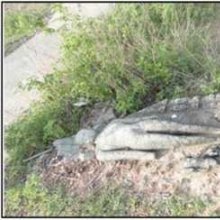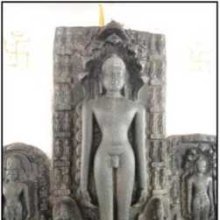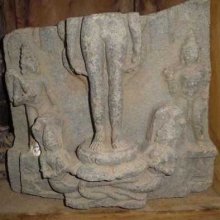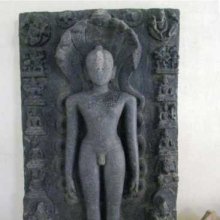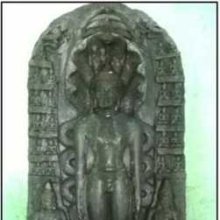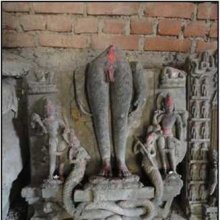Parshvanatha, Pārśvanātha, Parshva-natha: 10 definitions
Introduction:
Parshvanatha means something in Jainism, Prakrit, Hinduism, Sanskrit. If you want to know the exact meaning, history, etymology or English translation of this term then check out the descriptions on this page. Add your comment or reference to a book if you want to contribute to this summary article.
The Sanskrit term Pārśvanātha can be transliterated into English as Parsvanatha or Parshvanatha, using the IAST transliteration scheme (?).
Images (photo gallery)
(+61 more images available)
In Jainism
General definition (in Jainism)
Source: Wisdom Library: JainismPārśvanātha (पार्श्वनाथ) is another name for Pārśva, the twenty-third Tīrthaṅkara (Janism recognizes 24 such teachers or Siddhas). He is also known by the name Pārśvanātha. His colour is green (harita), according to Aparājitapṛcchā (221.5-7). His height is 9 hatha (4 hatha equals 1 dhanuṣa, which equals 6 feet), thus, roughly corresponding to 4.1 meters. His emblem, or symbol, is a Snake.
Pārśvanātha’s father is Aśvasena and his mother is Vāmā according to Śvetāmbara or Varmilā according to Digambara. It is an ancient Jain practice to worship the Tīrthaṅkara’s parents in various rites, such as the pratiṣṭhāvidhi, according to the Ācāradinakara (14th work on Jain conduct written by Vardhamāna Sūri).
Source: archive.org: The Jaina IconographyPārśvanātha (पार्श्वनाथ) refers to the twenty-third of twenty-four Tīrthaṃkaras or Jinas, commonly depicted in Jaina iconography.—Pārśvanātha is one of the greatest Tīrthaṃkaras or Prophets of Jainism. [...] From all sources, we gather his emblem or cognizance is a snake. In sculpture, snake seems to be everything with him. Not only do we find snake in the usual place of the symbol, we find, snakes canopy him with three or seven or eleven hoods. His Yakṣa is called Pārśva or Vāmana or Dharaṇendra and Yakṣiṇī is called Padmāvatī. The king, who stands by his side as a Chowri-bearer is known as Ajitarāja. The Devadāru (Deodar) or Dhātaki is his Kevala-tree.
Much isknown from Jaina Purāṇas and Caritas of Pārśvanātha’s personal and family history. He was probably born about 817 and died about 717 B.C. His father Aśvasena was the King of Benares. His mother’s name was Vāmā or Brahmā. Pārśva was a brave warrior and once he carried his victorious arms down to Kaliṅga. He married the daughter of King Prasenajit, King of Kośala, but like Prince Siddhārtha, he left his princess to follow the life of an ascetic at 30 years of age. He preached his doctrines of love and universal fraternity for about 70 years and finally attained liberation or Mokṣa on Mt. Summet Śikhara now called after him Giri Pārśvanātha Hill, in South Bihar.
The name of Pārśva has been explained in Jaina literature differently. “He touches (Spṛśati) all ideas by knowledge”—is one version. The name was given him because his mother before his birth while lying on her couch, saw a black serpent crawling about. This is the version ol the Pārśvanātha Carita also. Thirdly, he is the lord (Nātha) of his Yakṣa named Pārśva.
Source: archive.org: TrisastisalakapurusacaritraPārśvanātha (पार्श्वनाथ) or Pārśva refers to the twenty-third of the twenty-four Tīrthaṅkaras praised in the first book (ādīśvara-caritra) [chapter 1] of Hemacandra’s 11th century Triṣaṣṭiśalākāpuruṣacaritra: an ancient Sanskrit epic poem narrating the history and legends of sixty-three illustrious persons in Jainism.
Accordingly, “[...] we worship the Arhats, who at all times and all places purify the people of the three worlds by their name, representation, substance, and actual existence. [...] May the Lord Pārśvanātha, whose attitude of mind was the same toward Kamaṭha and Dharaṇendra while each was performing actions characteristic of himself, be for your emancipation”
Source: academia.edu: The epoch of the Mahavira-nirvanaParshvanatha, the 23rd Tirthankara.—According to Shrutyavatara of Indranandi, Parshvanatha flourished 250 years before Mahavira (1261-1189 BCE) and lived for 100 years. Therefore, the date of Parshvanatha can be fixed around 1539-1439 BCE. He was the son of King Ashvasena and Vamadevi. Ashvasena was the king of Varanasi.
Parshvanatha, the 23rd Tirthankar, revived the practice of Jainism 1550 years after Arishtanemi and finally, Mahavira, the 24th Tirthankara laid strong foundations of Jainism.
Source: academia.edu: Tessitori Collection IPārśvanātha (पार्श्वनाथ) or Pārśvanāthagīta refers to one of the twenty-four songs (gīta) embedded in the Caturviṃśatijinagīta by Jinarāja (dealing with classical hymns and stotras from Jain literature), which is included in the collection of manuscripts at the ‘Vincenzo Joppi’ library, collected by Luigi Pio Tessitori during his visit to Rajasthan between 1914 and 1919.

Jainism is an Indian religion of Dharma whose doctrine revolves around harmlessness (ahimsa) towards every living being. The two major branches (Digambara and Svetambara) of Jainism stimulate self-control (or, shramana, ‘self-reliance’) and spiritual development through a path of peace for the soul to progess to the ultimate goal.
Languages of India and abroad
Sanskrit dictionary
Source: DDSA: The practical Sanskrit-English dictionaryPārśvanātha (पार्श्वनाथ).—the Jaina pontiff. the 23 rd Tīrthaṅkara (Mar. pārasa- nātha).
Derivable forms: pārśvanāthaḥ (पार्श्वनाथः).
Pārśvanātha is a Sanskrit compound consisting of the terms pārśva and nātha (नाथ).
Source: Cologne Digital Sanskrit Dictionaries: Monier-Williams Sanskrit-English DictionaryPārśvanātha (पार्श्वनाथ):—[=pārśva-nātha] [from pārśva > pārśava] m. Name of a Jaina teacher (predecessor of Mahā-vīra), [Monier-Williams’ Buddhism 530]
[Sanskrit to German]
Sanskrit, also spelled संस्कृतम् (saṃskṛtam), is an ancient language of India commonly seen as the grandmother of the Indo-European language family (even English!). Closely allied with Prakrit and Pali, Sanskrit is more exhaustive in both grammar and terms and has the most extensive collection of literature in the world, greatly surpassing its sister-languages Greek and Latin.
Kannada-English dictionary
Source: Alar: Kannada-English corpusPārśvanātha (ಪಾರ್ಶ್ವನಾಥ):—[noun] = ಪಾರ್ಶ್ವ- [parshva-] 7.
Kannada is a Dravidian language (as opposed to the Indo-European language family) mainly spoken in the southwestern region of India.
See also (Relevant definitions)
Partial matches: Parshva, Natha.
Starts with: Parshvanathacaritra, Parshvanathadashabhavavisaha, Parshvanathagita, Parshvanathakavya, Parshvanathapurana, Parshvanathastava, Parshvanathastavana, Parshvanathastotra, Parshvanathastuti, Parshvanathatirtha, Parshvanathavivahalu.
Ends with: Godiparshvanatha, Pancasaraparshvanatha, Stambhanikaparshvanatha, Suparshvanatha.
Full-text (+170): Parshvanathakavya, Parshvanathagita, Parshvanathapurana, Parshvanathastuti, Parshvanathacaritra, Parshvanathastava, Parshvanathadashabhavavisaha, Shubhadatta, Parshva, Vama, Parisphita, Snatra, Parshvanathatirtha, Sarvabhisara, Sudhandhas, Meghamalin, Bhogamalini, Jhanjhamaruta, Vairangika, Bhogamkara.
Relevant text
Search found 18 books and stories containing Parshvanatha, Parshva-natha, Pārśva-nātha, Parsva-natha, Pārśvanātha, Parsvanatha; (plurals include: Parshvanathas, nathas, nāthas, Pārśvanāthas, Parsvanathas). You can also click to the full overview containing English textual excerpts. Below are direct links for the most relevant articles:
Jainism in Odisha (Orissa) (by Ashis Ranjan Sahoo)
Chapter 2: The origin of Jainism in Odisha (Orissa)
Parsvanatha image at Bhandesvara Siva Temple, Shripura < [Chapter 3: Survey of Jaina Antiquities in Odisha]
Jaina Antiquities at Basulei Thakurani, Sitalesvara < [Chapter 3: Survey of Jaina Antiquities in Odisha]
Sripura (Archaeological Survey) (by Bikash Chandra Pradhan)
Stone Images (2): Jaina Sculptures < [Chapter 3 - Sculptural Programme]
Jain Remains of Ancient Bengal (by Shubha Majumder)
Single depiction of Pārśvanātha sculptures < [Chapter 6 - Iconographic Study of Jaina Sculptural Remains]
Pañca-tīrthika type of Pārśvanātha sculptures < [Chapter 6 - Iconographic Study of Jaina Sculptural Remains]
Caubisi type of Pārśvanātha Sculptures < [Chapter 6 - Iconographic Study of Jaina Sculptural Remains]
Trishashti Shalaka Purusha Caritra (by Helen M. Johnson)
Part 1: Invocation < [Chapter II - Previous births of Pārśvanātha]
Part 7: Defense of Prasenajit < [Chapter III - Birth, youth, initiation, and omniscience of Śrī Pārśva]
Chapter IV - The wandering and emancipation of Pārśvanātha < [Book IX (b) - Pārśvanāthacaritra]
Vedic influence on the Sun-worship in the Puranas (by Goswami Mitali)
Part 4 - Anti-Vedic Religious System < [Chapter 3 - General Characteristics of the Purāṇic Religion and its Link with the Vedic Tradition]
A study of the philosophy of Jainism (by Deepa Baruah)
Chapter I.c - The lives of the Tīrthaṅkaras < [Chapter I - Introduction]
Related products
